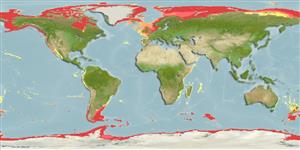Pseudosagitta maxima (Conant, 1896)
| Native range | All suitable habitat | Point map | Year 2050 |

|
| This map was computer-generated and has not yet been reviewed. |
| Pseudosagitta maxima AquaMaps Data sources: GBIF OBIS |
Hochladen Photos
Google Bild |
No photo available for this species.No drawings available for Sagittidae.
Google Bild |
No photo available for this species.
Classification / Names Common names | Synonyms | CoL | ITIS | WoRMS
| Aphragmophora | Sagittidae
Environment: milieu / climate zone / depth range / distribution range Ökologie
; tiefenbereich 0 - 2000 m (Ref. 1812), usually 0 - 600 m (Ref. 1812). Temperate; 5°C - 14°C (Ref. 1812); 75°N - 73°S, 0°E - 0°E
Verbreitung Länder | FAO Gebiete | Ecosystems | Vorkommen | Einführungen
Circumglobal.
Length at first maturity / Size / Gewicht / Alter
Maturity: Lm ? range ? - ? cm Max length : 9.0 cm BL Männchen/unbestimmt; (Ref. 2255)
One of the largest chaetognaths (Ref. 2255). Maximum depth reported taken from Ref. 116364. Inhabits mesopelagic (Refs. 116362, 116365) to bathypelagic zones (Ref. 3682).
Life cycle and mating behavior Geschlechtsreife | Fortpflanzung | Ablaichen | Eier | Fecundity | Larven
Members of the phylum Chaetognatha are hermaphroditic. Mating behavior: A preliminary visual signaling behavior for species recognition is observed to prevent predation. Life cycle: Eggs directly develop into miniature adults (hatchlings).
Hauptreferenz
Referenzen | Koordinator | Partner
Pierrot-Bultz, A.C. and K.C. Chidgey. 1988. (Ref. 2255)
IUCN Rote Liste Status (Ref. 130435)
CITES Status (Ref. 108899)
Not Evaluated
CMS (Ref. 116361)
Not Evaluated
Bedrohung für Menschen
Nutzung durch Menschen
| FishSource |
Tools
Mehr Information
Internet Quellen
BHL | BOLD Systems | CISTI | DiscoverLife | FAO(Publication : search) | Fishipedia | GenBank (Genom, nucleotide) | GloBI | Gomexsi | Google Books | Google Scholar | Google | PubMed | Tree of Life | Wikipedia (Gehe zu, Suchen) | Zoological Record
Estimates based on models
Preferred temperature
(Ref. 115969): 1.8 - 12.9, mean 7.2 (based on 5397 cells).
Preiskategorie
(Ref. 80766):
Unknown.


